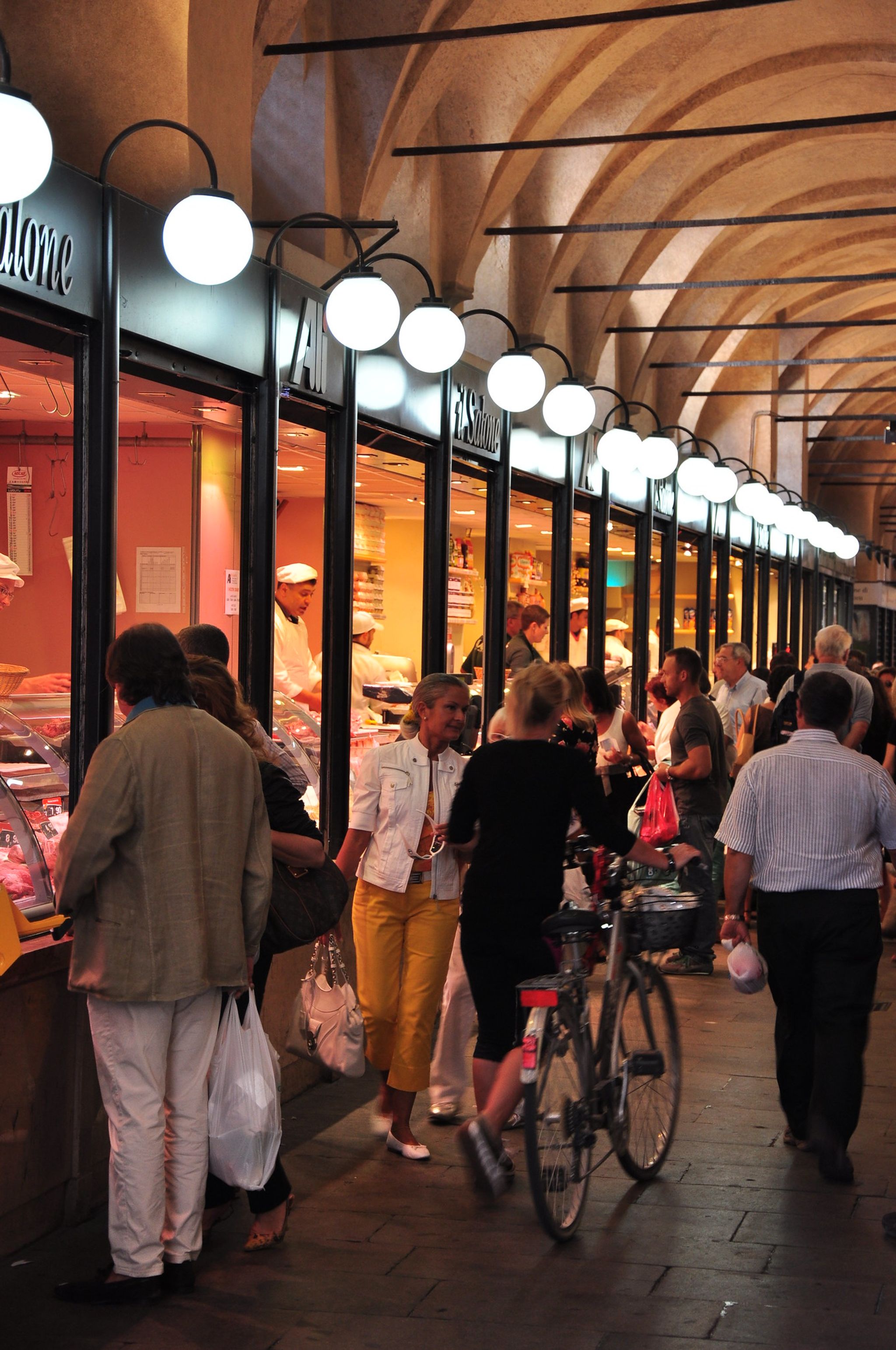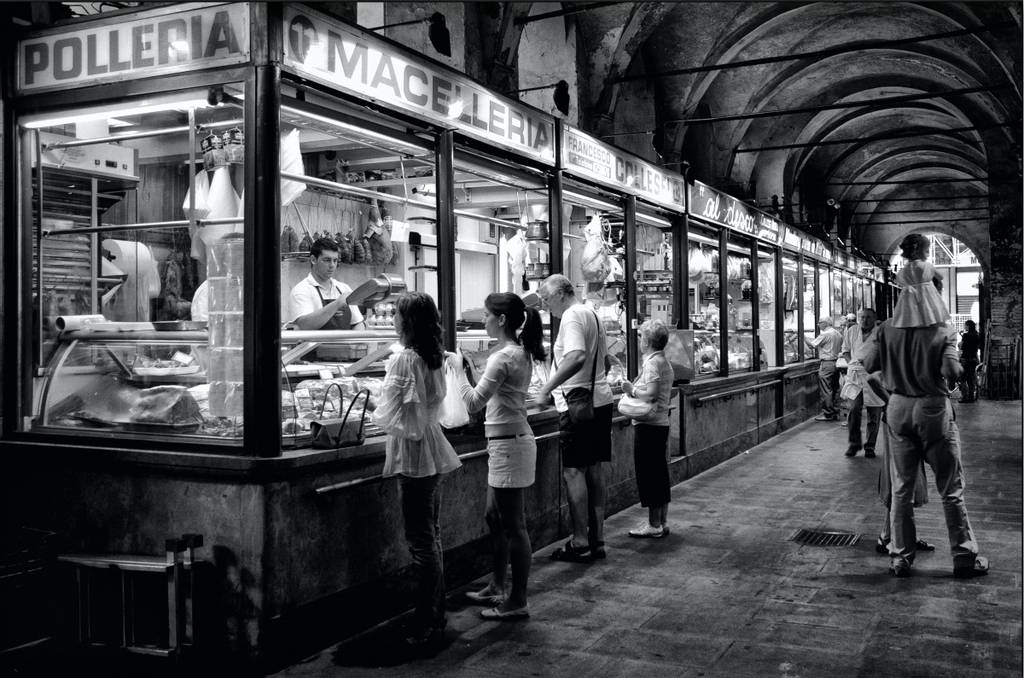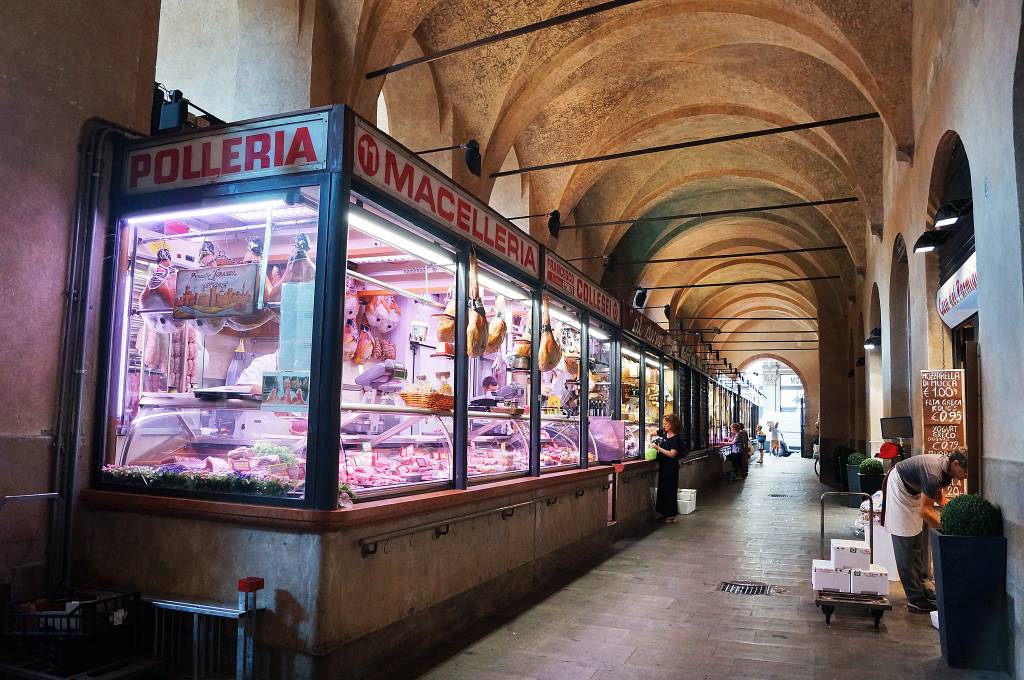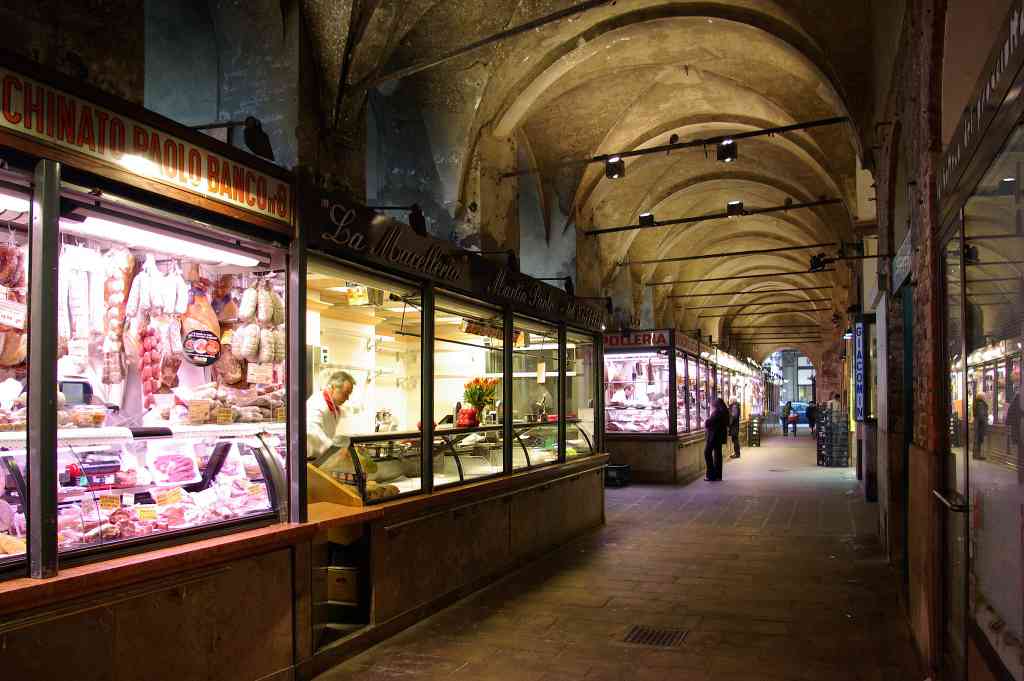The Market of Palazzo della Ragione
The Palazzo della Ragione, built in the Middle Ages as the seat of the city courts, still hosts on the ground floor one of the oldest European markets

The Palazzo della Ragione is the largest building constructed in Padua in the Middle Ages. For more than six centuries, during the Carrarese Lordship and the Venetian domination, the upper floor was dedicated to the town and justice administration, while the ground floor functioned as a commercial seat.
The palazzo separates the two main squares of the city, Piazza delle Erbe (Herbs Market) to the south and Piazza della Frutta (Fruit Market) to the north. With its roof in the peculiar shape of an overturned ship's hull, the building has one of the largest medieval halls still existing, the upper floor’s great hall or Il Salone. The access to the upper floor is via four stairways, two from each square. The stairs lead to two loggias, open onto the squares with arches of varying width; below, other arches create a portico occupied by shops.
Il Salone has a historically close relationship between justice, finances, and trading. The Great hall still preserves the famous Pietra del Vituperio or the Stone of Shame. It was designed back in the 13th century as a punishment for insolvent debtors and placed at the centre of the hall of justice. Here, in the presence of at least 100 witnesses, the debtor was forced to undress, remaining only in his shirt and underwear, pronounce their renunciation to worldly goods, and then banished from the city.
Volto della Corda
Towards Piazza della Frutta there’s another example of ancient public protection on mercantile activities. Volto della Corda (Face of the Rope) is an aerial passage built at the beginning of the fourteenth century to connect the Palazzo della Ragione and the Palazzo del Consiglio, one of the buildings of the municipal complex. The passage seems to own its name from the punishments that were performed here against traders who cheated on measures, swindlers, and insolvent debtors. They were lashed on the back with a rope. The rope always remained hanging from a stone ring fixed on the wall of the Volto to remind the sellers to be honest. Under the arch is the famous Canton de le busie (Corner of Lies), where are still visible the ancient Paduan measures carved on the white stone, preventing dishonest sellers from cheating their buyers.
The Market
Even if the close relationship between Il Salone and justice became obsolete over time, the function as commercial headquarters was maintained even 800 years later. The ground floor hosts the oldest European market, called Sotto il Salone.
The goods sold have changed over time: in the communal era, sellers of fine cloths and furs found their place here, and in the fifteenth century, delicatessens sellers and merchants cried their wares in the squares on both sides of the palazzo.
Today is active mainly in the food and beverage sector. More than fifty small shops offer quality food products such as cheeses, meats, and cured meats from all over Italy, wine bars, bars, and gift shops. Here are the most interesting.
Pastificio Artusi
Via Sotto il Salone 26, Padua, +39 049 8756770
Open Monday to Saturday from 9.00 to 13.00 and from 16.00 to 19.30.
The Artusi Pasta Factory produces fresh egg pasta, filled pasta, and potato gnocchi. The main feature of the shop is the production of artisanal pasta by bronze extruding, a process that makes the surface of the pasta wrinkled and rough, ideal for holding the sauce, and particularly suitable for full-bodied sauces.
The pasta is made with high-quality raw materials without glutamate or preservatives. Among the most exciting products are the traditional bigoli and tortellini stuffed with Gallina Padovana.
Pescheria Adriatica
Via Sotto il Salone 33/46, Padua, +39 049 8751304
Open Monday to Saturday from 8.30 to 13.00; from Thursday to Saturday also from 16.30 to 19.00.
In the heart of the Market stands the large Adriatic Fish Market, which has been open since the early 1950s. Fresh fish arrives every morning from the Chioggia Fish Market.
Among the shop’s specialities stand out the eels that swim in a large internal tank and sea bream, sea bass, octopus, squid, and seafood, which are cleaned and prepared with care and precision.
Casa del Parmigiano
Via Sotto il Salone 51, Padua, +39 049 876 3014
Open Monday to Thursday from 8.00 to 13.30 and from 15.30 to 19.00; on Friday and Saturday from 8.00 to 19.30.
Opened in 1944, The Parmesan House is managed by Roberto Carpanese, an award-winning seller from Padua. The store’s flagship is naturally the Parmigiano Reggiano, available in various ages, from 12 to 60 months.
There are also many other selected kinds of cheese available, from the fresh cheeses that arrive within 24 hours from small dairies scattered throughout Italy to more seasoned ones, arriving from mountain huts or rural dairies, and a selection of homemade cured meats.
La bottega del prosciutto
Via San Sotto il Salone 48, Padua, +39 049 650139
Open Monday from 8.00 to 13.00 and from Tuesday to Saturday from 8.00 to 13.00 and from 16.00 to 19.30.
La Bottega del Prosciutto has its asset in the selection of the best national hams, including San Daniele raw ham, Parma and Montagnana hams and Culatello di Zibello.
Excellent selection of cooked hams, including the famous Triestino cooked ham on the bone and Fiordistella Selezione Oro Negroni and a generous list of cold cuts, including Bresaola Punta d'Anca from Valtellina and Mortadella Due Torri di Bologna.
There is a vast assortment of local cured meats handcrafted with Italian meat, including cotechini, zamponi, salsicce, bondiole, and cappelletti.
Macelleria Bontà Equina
Via Sotto il Salone 19/20, Padua, +39 347 7567023
Open Monday to Saturday from 9.00 to 12.30 and from 15.30 to 19.30.
The Butcher’s Shop Bontà Equine, managed by Marco Maso, attests to the centuries-old Paduan tradition in horse meat slaughter.
Specialities of the shop are the cuts of horse meat such as ribs, the traditional straeche, the foal ossobuco, the equine salami, various types of frays (soft, rustic, and smoked), and many products ready for cooking, such as the ragu, the roast, and the foal saltimbocca.
We welcome all contributions, no matter how small. Even a spelling correction is greatly appreciated.
All submissions are reviewed before being published.
Continue to changelog-

© 'Sotto Salone' by Bex Walton is licensed under CC BY 4.0 Attribution copied to clipboard Failed copying attribution to clipboard -

© 'Sotto Salone' by Adriano Cantarello Attribution copied to clipboard Failed copying attribution to clipboard -

© 'The Market of Palazzo della Ragione (Padova)' by Stefano Sansavini is licensed under CC BY-SA 4.0 Attribution copied to clipboard Failed copying attribution to clipboard -

We welcome all contributions.
All submissions are reviewed before being published.
We welcome all contributions, no matter how small. Even a spelling correction is greatly appreciated.
All submissions are reviewed before being published.
Continue to changelogWe welcome all contributions, no matter how small. Even a spelling correction is greatly appreciated.
All submissions are reviewed before being published.
Continue to changelogWe welcome all contributions, no matter how small. Even a spelling correction is greatly appreciated.
All submissions are reviewed before being published.
Continue to changelogCategory
Cost
-
A true miracle of architectural audacity and an impressive collection of fourteenth-century mural paintings, the only secular and civil commission executed by Giotto in Padua
-
45 m
Piazza della Frutta, once called Piazza del Peronio, has been the commercial heart of Padua for centuries.
-
66 m
Piazza delle Erbe, one of the two squares that embrace the Palazzo della Ragione, is the temple of the Spritz cult and one of the most popular socializing places in Padua.
-
The Church of San Clemente is a small Baroque-style Roman Catholic church with an ancient history overlooking the Piazza dei Signori.
-
118 m
Palazzo Moroni, the usual name for the Municipal Buildings, is a complex of buildings in the city’s heart that house the offices of the Municipality of Padua.




